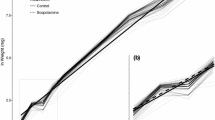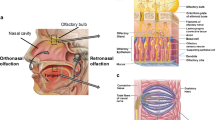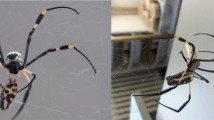Abstract
Sensitivity of caterpillars of Heliothis virescens, a generalist, and H. subflexa, a specialist, to eight different plant secondary compounds was examined behaviorally. The compounds were nicotine hydrogen tartrate, hordenine, caffeine, sinigrin, linamarin, arbutin, chlorogenic acid, and salicin. All compounds deterred feeding, at least at the higher concentrations, but the generalist was less affected than the specialist. Thus the hypothesis that specialists have greater sensitivity to deterrents than generalists was supported. In most cases deterrence occurred on first encounter, indicating that the response was sensory; in some cases short-term postingestive effects also appeared to play a role. The larger quantities of deterrent-containing food ingested by H. virescens sometimes resulted in measurable postingestive effects during the second control test. This did not occur in H. subflexa, which more commonly rejected the deterrent-containing food on first contact. The contrast between the species is discussed in relation to tradeoffs involved in different diet breadths.
Similar content being viewed by others
REFERENCES
Asaoka, K. 1994. Different spectrum in responses of deterrent receptor cells in Sawa-J, a strain of the silkworm, Bombyx mori, with abnormal feeding habit. Zool. Sci. II (suppl): 102.
Bernays, E. A. 1995. Effects of experience in host-plant selection, pp. 47-64, in R. Cardé and W. Bell (eds.). Chemical Ecology, Chapman and Hall, New York.
Bernays, E. A., and Chapman, R. F. 1987. The evolution of deterrent responses in plant-feeding insects, pp. 150-174, in R. F. Chapman, E. A. Bernays, and J. G. Stoffolano (eds.). Perspectives in Chemoreception and Behavior. Springer-Verlag, New York.
Bernays, E. A., and Chapman, R. F. 1994. Host Plant Selection by Phytophagous Insects. Chapman and Hall, New York.
Bernays, E. A., and Weiss, E. A. 1996. Induced food preferences in caterpillars: The need to identify mechanisms. Entomol. Exp. Appl. 78:1–8.
Blaney, W. M., Simmonds, M. S. J., Ley, S. V., and Katz, R. B. 1987. An electrophysiological and behavioural study of insect antifeedant properties of natural and synthetic drimane-related compounds. Physiol. Entomol. 12:281–291.
Blaney, W. M., Simmonds, M. S. J., Ley, S. V., and Jones, P. S. 1988. Insect antifeedants: A behavioural and electrophysiological investigation of natural and synthetically derived clerodane diterpenoids. Entomol. Exp. Appl. 46:267–274.
Fang, Q. Q., Cho, S., Regier, J. C., Mitter, C., Matthews, M., Poole, R. W., Friedlander, T. P. and Zhao, S. W. 1997. A new nuclear gene for insect phylogenetics: Dopa decarboxylase is informative of relationships within Heliothinae (Lepidoptera: Noctuidae). Syst. Biol. 46:269–283.
Glendinning, J. I. 1996. Is chemosensory input essential for the rapid rejection of toxic foods? J. Exp. Biol. 199:1523–1534.
Glendinning, J. I., and Slansky, F. 1994. Interactions of allelochemicals with dietary constituents: effects on deterrency. Physiol. Entomol. 19:173–186.
Glendinning, J. I., and Slansky, F. 1995. Consumption of a toxic food by caterpillars increases with dietary exposure: Support for a role of induced detoxification enzymes. J. Comp. Physiol. A 176:337–345.
Gould, F., Anderson, A., Reynolds, A., Bumgardner, L., and Moar, W. 1995. Selection and genetic analysis of a Heliothis virescens (Lepidoptera: Noctuidae) strain with high levels of resistance to Bacillus thuringiensis toxins. J. Econ. Entomol. 88:1545–1559.
Graham, H. M., and Robertson, O. T. 1970. Host plants of Heliothis virescens and H. zea (Lepidoptera: Noctuidae) in the lower Rio Grande valley, Texas. Ann. Entomol. Soc. Am. 3:1261–1265.
Huang, X. P., and Renwick, J. A. A. 1995. Chemical and experiential basis for rejection of Tropaeolum majus by Pieris rapae larvae. J. Chem. Ecol. 21:1601–1618.
Jermy, T. 1966. Feeding inhibitors and food preference in chewing phytophagous insects. Entomol. Exp. Appl. 9:1–12.
Lindroth, R. L. 1991. Differential toxicity of plant allelochemicals to insects: roles of enzymic detoxication systems, pp. 1-34, in E. A. Bernays (ed.). Insect-Plant Interactions, Vol. III. CRC Press, Boca Raton, Florida.
Mitchell, E. R., and Heath, R. R. 1987. Heliothis subflexa (Gn.). (Lepidoptera: Noctuidae): Demonstration of oviposition stimulant from groundcherry using novel bioassay. J. Chem. Ecol. 13:1849–1858.
Mitter, C., Poole, P. W., and Matthews, M. 1993. Biosystematics of the Heliothinae (Lepidoptera: Noctuidae). Annu. Rev. Entomol. 38:207–225.
Neunzig, H. H. 1969. The biology of the tobacco budworm and the corn earworm in North Carolina. Tech. Bull No. 196. North Carolina Agriculture Experiment Station, Raleigh.
Noldus, L. P. J. J. 1991. The observer: a software system for collection and analysis of observational data. Behav. Res. Methods Instrum. Comput. 23:415–429.
Schoonhoven, L. M., Jermy, T., and van Loon, J. J. A. 1998. Insect-Plant Biology. Chapman and Hall, London.
Sheck, A., and Gould, F. 1996. The genetic basis of differences in growth and behavior of specialist and generalist herbivore species: Selection on hybrids of Heliothis virescens and Heliothis subflexa. Evolution 50:831–841.
Snyder, M. J., and Glendinning, J. I. 1996. Causal connection between detoxification enzyme activity and consumption of a toxic plant compound. J. Comp. Physiol. A 179:255–261.
Sokal, R. R., and Rohlf, F. J. 1995. Biometry, 3rd ed. W. H. Freeman, New York.
Stadelbacher, E. A. 1981. Role of early-season wild and naturalized host plants in the buildup of the F1 generation of Heliothis zea and H. virescens in the delta of the Mississippi. Environ. Entomol. 10:766–770.
Usher, B. F., Bernays, E. A., and Barbehenn, R. V. 1988. Antifeedant tests with larvae of Pseudaletia unipuncta: Variability of behavioral responses. Entomol. Exp. Appl. 48:203–212.
Author information
Authors and Affiliations
Rights and permissions
About this article
Cite this article
Bernays, E.A., Oppenheim, S., Chapman, R.F. et al. Taste Sensitivity of Insect Herbivores to Deterrents is Greater in Specialists Than in Generalists: A Behavioral Test of the Hypothesis with Two Closely Related Caterpillars. J Chem Ecol 26, 547–563 (2000). https://doi.org/10.1023/A:1005430010314
Issue Date:
DOI: https://doi.org/10.1023/A:1005430010314




